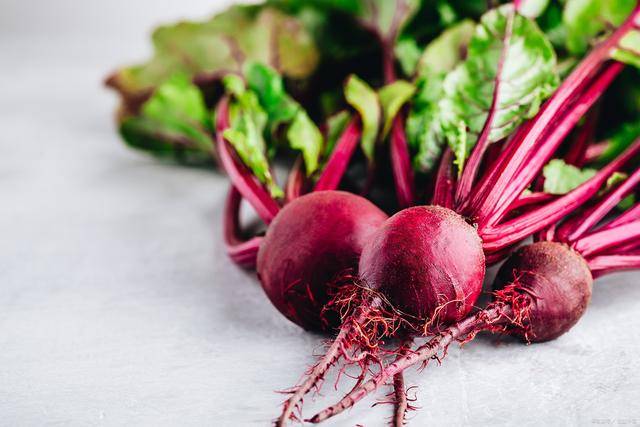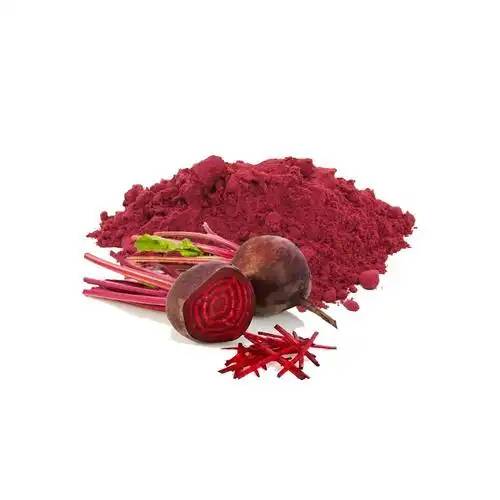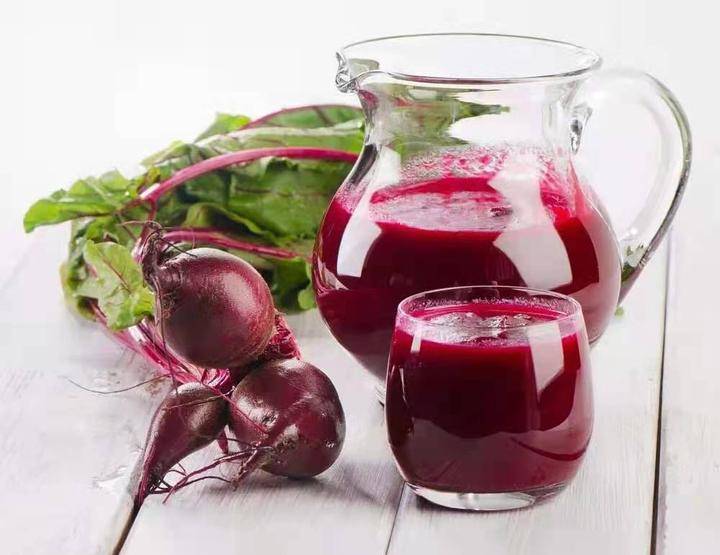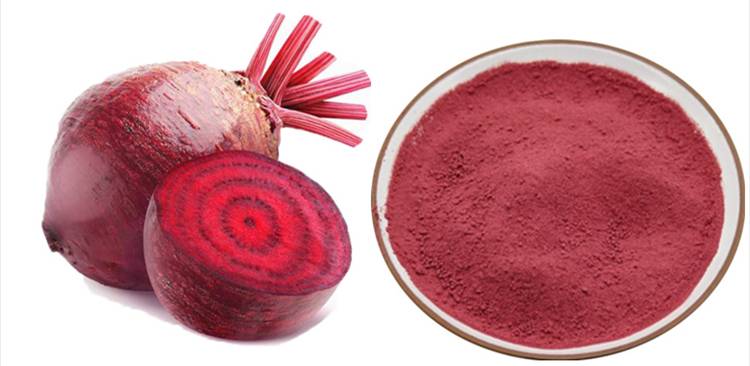Beetroot Extract Benefits of Antibacterial
Red beet (Beta vulgaris L. subsp. vulgaris) is a biennial green herbaceous crop with edible roots and leaves [1]. Human consumption of red beet is widespread. Currently, the United Kingdom, and North and Central America are the main producers of red beet [2].
Red beetroots are used in salads and soups, stews, grilled, pickled, and processed into jams, wines, and juices; whereas its leaves are also used as a food and as a substitute for cooked spinach, which is similar in color and texture to spinach, and is also rich in phytochemicals[1, 3-5].
The pigments extracted from red beet are widely used in food, decorative arts, painting, cosmetics, and medicine[6-7]. Red beet roots have high concentrations of betanin and low concentrations of betaflavin, which are water-soluble nitrogen compounds that are part of a group of phenolic plant secondary metabolites known as betalains or betalains.
Betanin is considered a better alternative to synthetic red dyes because it is natural and non-toxic to humans[8-9]. Red beet pigments are approved as food colors by the Food and Drug Administration (FDA) and the European Union (EU)[10]. These beet pigments are commercially used by the food industry to improve the color of dairy products, sauces, soups, confectionery, breakfast cereals, processed meats, and livestock products [8, 11-12], and by the pharmaceutical industry as a coloring agent for liquid and solid drug preparations [12-13].
Red beet is rich in antioxidants and studies have shown that it ranks tenth among plants in terms of antioxidant content[12]. It acts as a free radical scavenger and prevents diseases by enhancing oxidative damage to LDL, DNA, and proteins[14-15]. Beet contains high amounts of beet red, phenolic compounds, and ascorbic acid, all of which are well-known bioactive substances[12]. Since Roman times, beet has been used as a natural medicine. Many studies on the therapeutic potential of beet red pigments and phenolic compounds have been carried out and they possess antimicrobial, anti-inflammatory, antiulcer, antitumor, anticytotoxic, immunomodulatory and hepatoprotective properties[16-18].
1.The Antimicrobial and Antioxidant Activity of Red Beet Extract
The antioxidant components of red beet extract include betalains, phenols, and ascorbic acid; betalains are water-soluble nitrogenous plant pigments, including beet red pigment and beet yellow pigment, beet red pigment has beet aldanine, which is partially biologically active and highly antioxidant related to the nature of the antiradicals[20].
The overproduction of reactive oxygen (ROS) and reactive nitrogen (RNS) radicals is a byproduct of cellular metabolism, and the generation of free radicals induces oxidative stress, which is associated with adverse health effects[21-22]. For example, oxidative stress is responsible for sepsis (sepsis) in human infections caused by Gram-positive, Gram-negative bacteria and fungi[23]. When ROS are produced in the body, antioxidants are needed, as a first line of defense, which acts: on the target molecule, any substance delaying and preventing oxygenation damage [24].
The human body can produce and supply endogenous antioxidants through its metabolic processes [12]. However, under normal physiological conditions, the amount of effective endogenous antioxidants is sufficient to cope with the normal threshold of physiological rates of free radical production. Therefore, exogenous antioxidants from food sources are necessary when the free radicals are too high above the normal threshold [25].
Antioxidants from natural sources are effective in inhibiting certain microorganisms and have potential as antimicrobial agents [23]. In food preservation, antioxidants are effective in preventing spoilage due to oxidative damage, reduction of undesirable flavors, enzymatic browning, and nutrient loss, which are important factors for commercial exploitation [26]. Their antimicrobial properties also extend shelf-life and may reduce the incidence of foodborne illnesses through the use of food-active packaging and as a functional additive, or preservative in food products[27]. Moreover, other consumer products can also benefit from this natural antimicrobial agent, such as blemish creams and antimicrobial sprays.
A large body of literature is exploring antioxidant substances in red beets. Betanin and phenolic compounds are known to be the main antioxidants available, and observational evaluations of the antibacterial activity of red beet extracts have been carried out [28]. However, a few studies have found that the antimicrobial activity of red beet extracts is associated with specific antioxidants, and there is a need to clarify the mode of inhibition of different antioxidants and whether they are synergistic or not, and the identification of such substances may have an important role in the antimicrobial activity.
2.Antibacterial Activity of Beet Red
Red beet is traditionally used as a herbal medicine for the treatment of infectious diseases, and the study of antioxidant and antimicrobial active extracts of red beet provides a basis for exploring the antimicrobial potential. In general, red beet extracts possess antimicrobial activity and inhibit a wide range of Gram-positive and Gram-negative bacteria; however, they do not inhibit fungi and yeasts [12, 30].
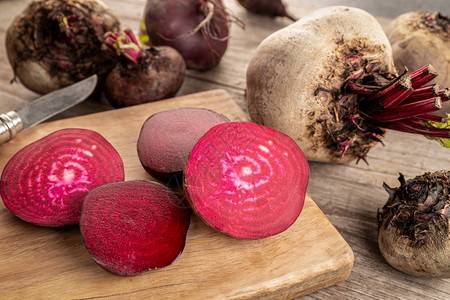
Gram-positive bacteria were more sensitive to red beet extract than Gram-negative bacteria [31]. The high sensitivity was attributed to the inhibitory effect of the polyphenolic compounds in the extract by disrupting the single cell wall structure of Gram-positive bacteria [32]. The Bacillus group of Gram-positive bacteria is in dormant, resistant, spore-forming condition and can survive harsh environmental conditions [33].
For example, Bacillus cereus (B. cereus) infects food-poisoning substances undetectable in raw food, and during heat sterilization, it survives in the form of spores [34]; this bacterium mainly infects meat and dairy products, soups, pasta, rice, sauces, pastries and vegetables [35].
B. anthracis is a stable and virulent microorganism that can cause anthrax fever when undercooked contaminated meat is consumed [36]. Other Gram-positive bacteria such as Staphylococcus and Streptococcus pathogens are the main source of heat-resistant acid-resistant staphylococcal enterotoxins (SEs), which can cause food poisoning and contamination when contaminated products are insufficiently disinfected and when pathogenic food is mishandled [37-38].
Gram-negative Escherichia coli (E. coli 0157: H7) and Salmonella typhimurium (S. typhimurium) are lethal and pose a higher risk to the food processing industry [40]. Previously, in 2006, an outbreak of E. coli 0157:H7 infected fresh bags of young spinach in the United States and Canada, resulting in 205 cases of serious health decline and three deaths; there have also been outbreaks in Africa, Europe, Japan, the United Kingdom, and other countries[41]. The deadly strain, E. coli 0157:H7, commonly parasitizes beef, raw milk, poultry, dry fermented sausages, vegetables, bean sprouts, fresh apple juice, and drinking water, and causes hemorrhagic colitis, hemolytic uremic syndrome, and severe hemorrhagic diarrhea [41].
The red beet extract showed the largest circle of inhibition (23 mm) against the Gram-positive bacterium S. epidermidis. In addition, the minimum inhibitory concentration (MIC) and minimum bactericidal concentration (MBC) for Staphylococcus epidermidis (S. epidermidis) were 20 and 40 mg/mL, respectively [42]. In another study, Bacillus cereus (B. cereus) was almost resistant to red beet extract (zone of inhibition 8 mm), and the most resistant were gram-negative Escherichia coli (E. coli) and S. typhi[42] .
3. Antimicrobial Applications of Red Beet Extracts
This property ensures that betalains can be used in neutral or low pH applications in the food, pharmaceutical, and cosmetic industries[8]. Due to microbial-induced deterioration of food, resulting in discoloration, off-flavors, lipid oxidation, shelf-life limitation, and loss of taste, texture, and nutritional value, there is a need for inexpensive, safe, edible, and bioactive packaging materials in the food industry[48].
Several research groups have investigated the antimicrobial potential of biodegradable films combined with red beet components. A combination of rosemary, ascorbic acid, red beet, and sodium lactate was used to determine the increase in shelf life and microbial growth of fresh pork sausages from 8 to 16 d by reducing pigment loss and oxidative reactions, and it was found that the betalains were able to maintain the color, moisture, unchanged texture, and thiobarbituric acid reactive substances of fresh pork sausages [49-50]. Gelatin capsules based on biofilms combined with beet pomace powder were also effective in primary oxidative protection of sunflower oil; therefore, these films are promising as antioxidant packaging materials[51]. Incorporation of red beet-rich root powder into starch-based bioelastomers is highly effective in DPPH and ABTS+ activities, thus, innovating active packaging materials for food preservation[52].
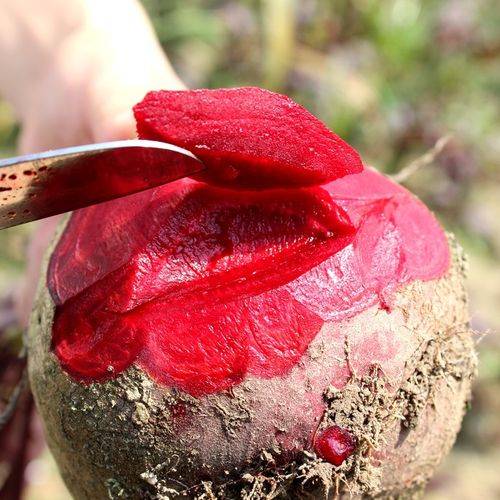
The antimicrobial and antioxidant activity of the packaged food decreased with the duration of storage, including the reaction of betalains with free radical molecules produced by lipid oxidation and the migration of betalains from the membrane into the food[49]. In addition, these betalain molecules can be absorbed by the human body, and food materials packaged in these films have been shown to have health benefits due to betalain intake[53] .
The antimicrobial activity of an herbal energy drink made from A. marmelos, R. cordifolia, P. emblica, and B. vulgaris has been studied and the antimicrobial assay of the drink showed a 2.1 mm circle of inhibition against the Gram-negative bacterium Salmonella enterica. Gram-positive bacteria such as S. epidemidis, B. cereus, and S. aureus showed circles of inhibition of 2.1 mm, 1.9 mm, 1.8 mm, and 1.5 mm, respectively; thus, this energy drink could be a good antioxidant and antibacterial source with potential therapeutic effects on infectious diseases [ 54]. In addition, the betalains of red beet were effective in attenuating the formation of meladic reaction products as demonstrated by the reduction of furosemide production by simulating early heat treatment of the milk system. Therefore, the potential utilization of these pigments may be beneficial to the food industry [55].
In terms of skin care products, the natural active ingredients of red beet extracts can be effectively used to treat infections, acne and skin radiation. For example, acne caused by Staphylococcus aureus (S. aureus) is very sensitive to these extracts in vitro[56]. In addition, this preparation protects the skin from oxidative processes, acts as a natural detoxifier, brightens the skin and prevents skin inflammation[56].
Another promising area for red beet extracts is in the treatment of microbial infections and in the first aid treatment of wounds. For example, red beet root extract encapsulated in silver nanoparticles possesses extreme toxicity and bactericidal properties against a broad spectrum of microorganisms such as Escherichia coli (E. coli), Pseudomonas aeruginosa (P. aeruginosa), Staphylococcus aureus (S. aureus) and Staphylococcus aureus (S. aureus)[57].
Red beet pigment is also expected to be used as a live cell imaging probe for Plasmodium infected erythrocytes and the treatment of infections caused by malaria parasites[58] . An in vivo simulation test of antimalarial activity of aqueous extract of red beet (50 mg/kg) against P. berghei in mice showed that aqueous extract of beet (B. vulgaris L.) was more effective than aqueous extracts of D. angustifolia, B. buonopozense and P. amboinicus [59].
4.Outlook
The main drawback of red beet is its earthy odor and off-flavor, which limits its application potential especially in food or beverage products. This problem can be overcome by extracting and isolating specific phytochemical antioxidants from sugar beet, followed by encapsulation of the antioxidants. Encapsulation technology can improve the stability and applicability of the product into high value products, functional foods and nutritional supplements.
References:
[1]Neelwarne, B., & Halagur, S. B. Red beet: an overview.//In B. Neelwarne (Ed.), Red Beet Biotechnology: Food and Pharmaceutical Applications[M]. New York: Springer, 2012: 1-43.
[2]Gengatharan, A., Dykes, G. A., & Choo, W. S. Betalains: natural plant pigments with potential application in functional foods[J]. LWT-Food Science and Technology, 2015, 64(2): 645-649.
[3]Biondo, P. B. F., Boeing, J. S., Barizo, R. O., et al. Evaluation of beetroot (Beta vulgaris L.) leaves during its developmental stages: a chemical composition study[J]. Food Science and Technology (Campinas), 2014, 34(1): 94-101.
[4]Wruss, J., Waldenberger, G., Huemer, S., et al. Compositional characteristics of commercial beetroot products and beetroot juice prepared from seven beetroot varieties grown in Upper Austria[J]. Journal of Food Composition and Analysis, 2015, 42: 46-55.
[5]Guldiken, B., Toydemir, G., Nur Memis, K., et al. Home-processed red beetroot (Beta vulgaris L.) products: changes in antioxidant properties and bioaccessibility[J]. International Journal of Molecular Sciences, 2016, 17(6): 858.
[6]Esatbeyoglu, T., Wagner, A. E., Schini-Kerth, V. B., & Rimbach, G. Betanin—a food colorant with biological activity[J]. Molecular
Nutrition & Food Research, 2015, 59(1): 36-47.
[7]Sainath, M., Kumar, K. S., & Babu, K. A. Formulation and evaluation of herbal lipstic. International Journal of Advanced Research In Medical & Pharmaceutical Sciences (IJARMPS), 2016, 1(1): 14-19.
[8]Azeredo, H. Betalains: properties, sources, applications, and stability—a review [J]. International Journal of Food Science and Technology, 2009, 44(12): 2365-2376.
[9]Elbandy, M. A., & Abdelfadeil, M. G. Stability of betalain pigments from a red beetroot (Beta vulgaris) [J]. Egyptian Journal Food Science, 2008, 36: 49-60.
[10]Wrolstad, R. E., & Culver, C. A. Alternatives to those artificial FD&C food colorants[J]. Annual Review of Food Science and Technology, 2012, 3(3), 59-77.
[11]Singh, B., & Hathan, B. S. Chemical composition, functional properties and processing of beetroot—a review[J]. International Journal of Scientific & Engineering Research, 2014, 5(1): 679-684.
[12]S Kumar,SL Brooks. Use of Red Beet (Beta vulgarisL.) for Antimicrobial Applications—a Critical Review[J]. Food & Bioprocess Technology, 2017, 2: 1-26
[13]Pai, S. R., & D ’Mello, P. Stability evaluation of beetroot colour in various pharmaceutical matrices [J]. Indian Journal of Pharmaceutical Sciences, 2004, 66(5): 696-699.
[14]Chang, S., Hsieh, C., & Yen, G. The protective effect of Opuntia dillenii Haw fruit against low-density lipoprotein peroxidation and its active compounds[J]. Food Chemistry, 2008, 106(2): 569-575.
[15]Uttara, B., Singh, A. V., Zamboni, P., et al. Oxidative stress and neurodegenerative diseases: a review of upstream and downstream antioxidant therapeutic options[J]. Current Neuropharmacology, 2009, 7(1): 65-74.
[16]Clifford, T., Howatson, G., West, D. J., & Stevenson, E. J. The potential benefits of red beetroot supplementation in health and disease[J]. Nutrients, 2015, 7(4): 2801-2822.
[17]Gandía-Herrero, F., Escribano, J., & García-Carmona, F. Biological activities of plant pigments betalains[J]. Critical Reviews in Food Science and Nutrition, 2016, 56(6): 937-945.
[18]Cho, J., Bing, S. J., Kim, A., et al. Beetroot (Beta vulgaris) rescues mice from γ-ray irradiation by accelerating hematopoiesis and curtailing immunosuppression[J]. Pharmaceutical Biology, 2017, 55(1): 306-319.
[19]Manohar, C. M., Kundgar, S. D., et al. Betanin immobilized LDPE as antimicrobial food wrapper[J]. LWT-Food Science and
Technology, 2016, 80: 131-135.
[20]Gandía-Herrero, F., Escribano, J., et al. Purification and antiradical properties of the structural unit of betalains[J]. Journal of Natural Products, 2012, 75(6): 1030-1036.
[21]Sen, S., Chakraborty, R., Sridhar, C., Reddy, Y., & De, B. Free radicals, antioxidants, diseases and phytomedicines: current status and future prospect[J]. International Journal of Pharmaceutical Sciences Review and Research, 2010, 3(3): 91-100.
[22]Sharma, P., Jha, A. B., Dubey, R. S. & Pessarakli, M. Reactive oxygen species, oxidative damage, and antioxidative defense
mechanism in plants under stressful conditions[Z]. Journal of Botany, 2012 doi:10.1155/2012/217037.
[23]Prauchner, C. A. Oxidative stress in sepsis: pathophysiological implications justifying antioxidant co-therapy[J]. Burns, 2017, 43(3): 471-485.
[24]Lobo, V., Patil, A., Phatak, A., & Chandra, N. Free radicals, antioxidants and functional foods: impact on human health [J]. Pharmacognosy Reviews, 2010, 4(8): 118.
[25]Benzie, I. F. Evolution of dietary antioxidants [J]. Comparative Biochemistry and Physiology Part A: Molecular & Integrative Physiology, 2003, 136(1): 113-126.
[26]Shahidi, F., & Zhong, Y. Novel antioxidants in food quality preservation and health promotion[J]. European Journal of Lipid Science and Technology, 2010, 112(9): 930-940.
[27]Siripatrawan, U., & Noipha, S. Active film from chitosan incorporating green tea extract for shelf life extension of pork sausages[J]. Food Hydrocolloids, 2012, 27(1): 102-108.
[28]Vulic, J. J., Cebovic, T. N., Canadanovic-Brunet, J. M., et al. In vivo and in vitro antioxidant effects of beetroot pomace extracts[J]. Journal of Functional Foods, 2014, 6(1): 168-175.
[29]Gyawali, R., & Ibrahim, S. A. Natural products as antimicrobial agents[J]. Food Control, 2014, 46: 412-429.
[30]Vulic, J. J., Cebovic, T. N., Canadanovic, V. M., et al. Antiradical, antimicrobial and cytotoxic activities of commercial beetroot pomace[J]. Food & Function, 2013, 4(5): 713-721.
[31]Canadanovic-Brunet, J., Savatovic, S. S., Cetkovic, G. S., et al. Antioxidant and antimicrobial activities of beet root pomace extracts[J]. Czech Journal of Food Sciences, 2011, 29(6): 575-585.
[32]Daglia, M. Polyphenols as antimicrobial agents[J]. Current Opinion in Biotechnology, 2012, 23(2): 174-181.
[33]Vilas -Boas, G. T., Peruca, A., & Arantes, O. Biology and taxonomy of Bacillus cereus, Bacillus anthracis, and Bacillus thuringiensis[J]. Canadian Journal of Microbiology, 2007, 53(6): 673-687.
[34]Guinebretière, M., Auger, S., Galleron, N., et al. Bacillus cytotoxicus sp. nov. is a novel thermotolerant species of the Bacillus cereus group occasionally associated with food poisoning[J]. International Journal of Systematic and Evolutionary Microbiology, 2013, 63: 31-40.
[35]Granum, P. E. Bacillus cereus[Z]. Foodborne pathogens: microbiology and molecular biology, 2005: 409-419.
[36]Chakraborty, A., Khan, S. U., Hasnat, M. A., et al. Anthrax outbreaks in Bangladesh, 2009-2010[J]. The American Journal of Tropical Medicine and Hygiene, 2012, 86(4): 703-710.
[37]Le Loir, Y., Baron, F., & Gautier, M. Staphylococcus aureus and food poisoning[J]. Genetics and Molecular Research, 2003, 2(1): 63-76.
[38]Pinchuk, I. V., Beswick, E. J., & Reyes, V. E. Staphylococcal enterotoxins[J]. Toxins, 2010, 2: 2177-2197.
[39]Delcour, A. H. Outer membrane permeability and antibiotic resistance[J]. Biochimica et Biophysica Acta (BBA)-Proteins and Proteomics, 2009, 1794(5): 808-816.
[40]McCallum, L., Paine, S., Sexton, K., et al. An outbreak of Salmonella typhimurium phage type 42 associated with the consumption of raw flour[J]. Foodborne Pathogens and Disease, 2013, 10(2): 159-164.
[41]Newell, D. G., Koopmans, M., Verhoef, L., et al. Food-borne diseases—the challenges of 20 years ago still persist while new ones continue to emerge[J]. International Journal of Food Microbiology, 2010, 139: S3-S15.
[42]Koochak, H., Seyyednejad, S. M., & Motamedi, H. Preliminary study on the antibacterial activity of some medicinal plants of Khuzestan (Iran) [J]. Asian Pacific Journal of Tropical Medicine, 2010, 3(3): 180-184.
[43]Velicanski, A. S., Cvetkovic, D. D., Markov, S. L., et al. Antibacterial activity of Beta vulgaris L. pomace extract[J]. APTEFF, 2011, 42: 263-269.
[44]Rauha, J., Remes, S., Heinonen, M., et al. Antimicrobial effects of Finnish plant extracts containing flavonoids and other phenolic compounds[J]. International Journal of Food Microbiology, 2000, 56(1): 3-12.
[45]Cushnie, T. T., & Lamb, A. J. Recent advances in understanding the antibacterial properties of flavonoids[J]. International Journal of Antimicrobial Agents, 2011, 38(2): 99-107.
[46]Cetin -Karaca, H., & Newman, M. C. Antimicrobial efficacy of natural phenolic compounds against gram positive foodborne pathogens[J]. Journal of Food Research, 2015, 4(6): 14-27.
[47]Santas, J., Almajano, M. P., & Carbó, R. Antimicrobial and antioxidant activity of crude onion (Allium cepa L.) extracts [J]. International journal of food science & technology, 2010, 45(2): 403-409.
[48]Gómez-Estaca, J., López-de-Dicastillo, C., Hernández-Muñoz, P., et al. Advances in antioxidant active food packaging[J]. Trends in Food Science & Technology, 2014, 35(1): 42-51.
[49]Martínez, L., Cilla, I., Beltrán, J. A., & Roncalés, P. Combined effect of modified atmosphere packaging and addition of rosemary (Rosmarinus officinalis), ascorbic acid, red beet root (Beta vulgaris), and sodium lactate and their mixtures on the stability of fresh pork sausages[J]. Journal of Agricultural and Food Chemistry, 2006, 54(13): 4674-4680.
[50]Zamudio-Flores, P. B., Ochoa-Reyes, E., Ornelas-Paz, J. D. J., et al. Effect of storage time on physicochemical and textural properties of sausages covered with oxidized banana starch film with and without betalains[J]. CyTA-Journal of Food, 2015, 13(3): 456-463.
[51]Iahnke, A. O. E. S., Costa, T. M. H., de Oliveira Rios, et al. Antioxidant films based on gelatin capsules and minimally processed beet root (Beta vulgaris L. var. Conditiva) residues[J]. Journal of Applied Polymer Science, 2016, 133(10): 43094.
[52]Tran, T. N., Athanassiou, A., Basit, A., & Bayer, I. S. Starch-based bio-elastomers functionalized with red beetroot natural antioxidant[J]. Food Chemistry, 2017, 216: 324-333.
[53]Frank, T., Stintzing, F. C., Carle, R., et al. Urinary pharmacokinetics of betalains following consumption of red beet juice in healthy humans[J]. Pharmacological Research, 2005, 52(4): 290-297.
[54]Jha, R., & Gupta, R. K. Development of energy drink containing Aegle marmelos, Rubia cordifolia, Phyllanthus emblica and Beta vulgaris and its phytochemical, nutritive and antimicrobial analysis[J]. Journal of Pharmacognosy and Phytochemistry, 2016, 5: 186-193.
[55]Rackauskienē, I., Pukalskas, A., Venskutonis, P. R.,et al. Effects of beetroot (Beta vulgaris) preparations on the Maillard reaction products in milk and meat-protein model systems[J]. Food Research International, 2015, 70: 31-39.
[56]Bezalwar Pratik, M., Gomashe Ashok, V., & Gulhane Pranita, A. A quest of anti -acne potential of herbal medicines for extermination of MDR Staphylococcus aureus[J]. International Journal of Pharmaceutical Science Invention, 2014, 3: 12-17.
[57]Bindhu, M. R., & Umadevi, M. Antibacterial and catalytic activities of green synthesized silver nanoparticles[J]. Spectrochimica Acta Part A: Molecular and Biomolecular Spectroscopy, 2015, 135: 373-378.
[58]Gonçalves, L. C. P., Tonelli, R. R., Bagnaresi, P., et al. A nature-inspired betalainic probe for live-cell imaging of Plasmodium- infected erythrocytes[J]. PloS One, 2013, 8(1): e53874.
[59]Albohiri, H. H., Al-Zanbagi, N. A., & Albohairi, S. H. In vivo trials of potential antimalarial from Beta vulgaris extracts in Jeddah, Saudi Arabia[J]. World Journal of Zoology, 2016, 11: 86-96.
-
Prev
Coenzyme Q10's Role in Advanced Anti-Fatigue Supplements
-
Next
Natural Ingredient Cistanche Tubulosa Extract Empowers Health Products


 English
English French
French Spanish
Spanish Russian
Russian Korean
Korean Japanese
Japanese